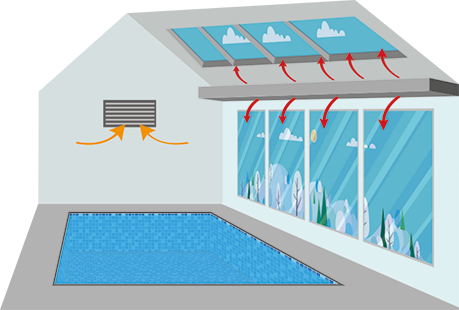
What ventilation for the indoor pool?
The indoor or covered swimming pool has real advantages, first of all, being able to enjoy swimming all year round. There is still a shadow on the board: condensation which can be an annoyance or even a scourge if its management is not taken care of. To limit humidity, we can play on the factors that favor its creation. Ventilation is one of these means. But how do you limit condensation in an indoor pool?
The different ventilation options for the indoor pool
Nothing is more annoying than seeing the walls of the pool enclosure become covered with condensation, seeing opaque traces appear that give a neglected impression or seeing the space of your indoor pool deteriorate due to humidity.
Natural ventilation
Natural ventilation consists of renewing the air in the indoor swimming pool with the outside air. All you have to do is open the doors, the windows... A simple gesture that can be applied when the need arises.
It is an effective solution for small volumes, when the swimming pool is under a low shelter or for a spa room for example but insufficient for a swimming pool hall.
In summer, the outside air is more or less similar to that of the water room, ventilation natural is effective and can be done easily by opening the shelter, doors and other openings. But when the mid-seasons or winter arrive, the outside air is much colder than that of the aquatic room. Once aeration has been carried out, the renewed air must be warmed up if you want a pleasant swim. To combat humidity in the water room, ventilation helps but it is not the sufficient and ideal solution for large volumes.
What about Controlled Mechanical Ventilation, then?

It is possible to install Controlled Mechanical Ventilation for an indoor pool or a covered pool. It is ideally installed during the construction of the swimming pool room, to hide the pipes as best as possible.
The purpose of a VMC is to renew the air in the room and exhaust stale moist air to the outside. The VMC must be specially designed for the aggressive environment of a swimming pool (chlorine in particular). It is preferable to choose a VMC with double flow, because the single flow, although less expensive, allows more heat loss. Which is not ideal for an indoor or covered pool. The opinion and advice of a professional are often essential.
In any case, to combat condensation in the pool room, a VMC alone is not always sufficient. The ideal is to couple it with a dehumidifier. If the VMC renews the air in the room, the dehumidifier extracts the humidity contained in the air. These two pieces of equipment are complementary. A preliminary study, during the design of the project, can define the needs and the tools necessary to effectively fight against condensation.
Knowing what the conditions are for controlling condensation will allow you to understand the different possibilities for effectively combating this phenomenon which is created in the space of the indoor swimming pool. If it is possible to limit condensation with swimming pool covers, combating condensation using a swimming pool dehumidifier remains the most appropriate way. Then discover the difference between the chemical dehumidifier VS electric dehumidifier and whether it is better to choose a swimming pool dehumidifier or Controlled Mechanical Ventilation to correctly choose the device best suited to your installation.